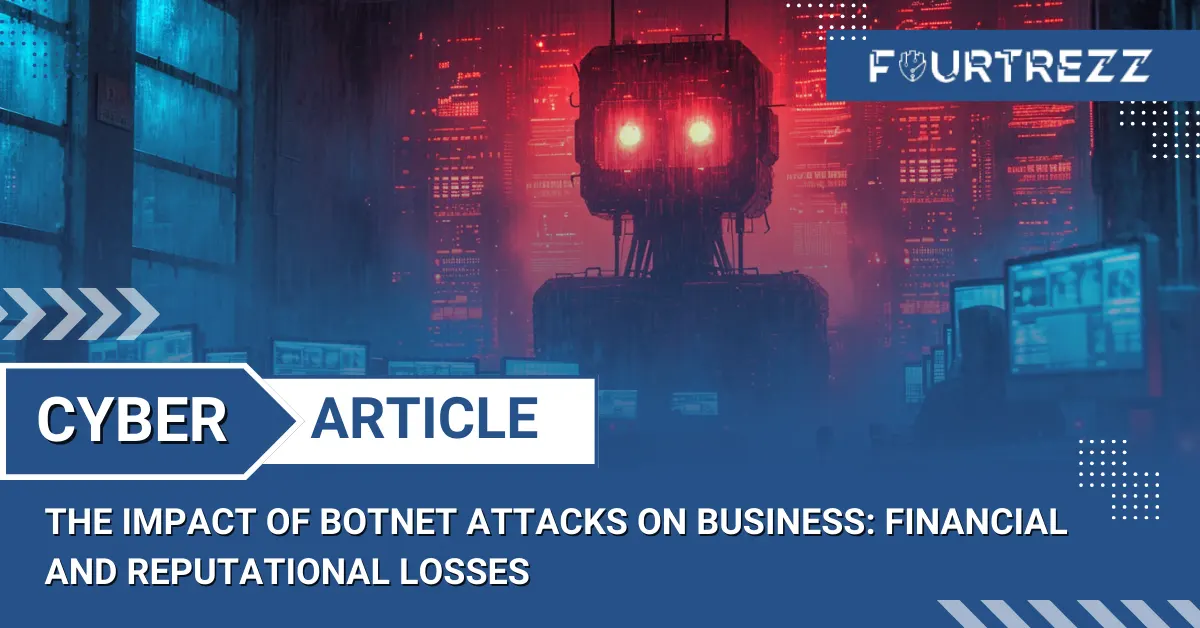Senin, 15 Januari 2024 | 4 min read | Andhika R
The Impact of Botnet Attacks on Business: Financial and Reputational Losses
Botnet attacks are a type of cybersecurity threat carried out by a network of computers infected with malware. Cybercriminals typically create botnets to engage in activities like data theft, spam distribution, or DDoS attacks.
Botnets operate by using infected devices as "bots" linked to a command and control (C&C) server controlled by the cybercriminals. The C&C server can issue commands to the bots, such as sending spam or launching DDoS attacks on specific targets. Botnets can also self-update by refreshing the malware used to infect more devices.
This article will detail how botnets function and the techniques cybercriminals use to control them.

Why are Botnet Attacks a Serious Threat to Businesses?
Botnet attacks pose a serious threat to businesses due to their potentially devastating impact. They can be used to steal critical company data, disrupt systems, or even paralyze business operations. Key reasons why botnet attacks are a serious threat include:
- Infecting employee devices: Botnets can spread through phishing emails or infected websites, infecting employee devices. Once infected, the botnet can take control and access sensitive data.
- Data theft: Botnets can steal company data, including customer information, trade secrets, or financial details. The stolen data can be used maliciously, like identity theft or financial fraud.
- System damage: Botnets can disrupt company systems or paralyze business operations. For example, DDoS attacks launched by botnets can make company websites inaccessible to users or customers.
- Increased operational costs: Businesses victimized by botnet attacks face higher operational costs, such as system recovery expenses or repairing attack damages.
Techniques Used in Botnet Attacks
- Distributed Denial-of-Service (DDoS) Attacks: The most common technique used in botnet attacks. Here, the botnet overwhelms a target server with excessive requests, rendering it nonfunctional.
- Phishing: Cybercriminals also use phishing to steal personal information. They create fake websites or emails mimicking legitimate ones to deceive victims into giving sensitive information.
- Malware: Attackers use malware to hijack computers and incorporate them into their botnet. Malware can appear as viruses, worms, Trojan horses, etc.
- Man-in-the-Middle (MitM) Attacks: These involve hijacking network or computer communications to intercept and record transmitted data.
- Keystroke Logging: This technique records every keystroke made by the victim, allowing attackers to steal sensitive information like passwords and credit card numbers.
Preventing and Responding to Botnet Attacks
- Implement strong and timely security policies, including strong passwords, regular security updates, and protection against malware and phishing attacks.
- Use reliable, up-to-date security software to directly prevent botnet attacks or provide early warnings.
- Monitor networks and systems regularly to detect early signs of botnet attacks.
- Train employees to recognize and avoid cyber threats, including botnet attacks.
- Employ botnet detection technology to identify unusual network traffic patterns or data volumes.
- Regularly update software and systems to reduce vulnerabilities exploitable by botnet attacks.
- Utilize botnet removal technology to eliminate botnets from systems and networks.
By following these steps, organizations can reduce the likelihood of botnet attacks or at least mitigate their impact.
The Financial and Reputational Impact of Botnet Attacks on Businesses
Botnet attacks are a significant threat worldwide. They facilitate various attacks, including DDoS, phishing, and malware. This article discusses the financial and reputational losses businesses can suffer from botnet attacks.
Financial Losses One of the most significant impacts of botnet attacks is the substantial financial loss. Botnets can be used for direct monetary theft, altering software configurations, or stealing personal and financial data. The cost of repairing damages from botnet attacks can reach millions of dollars.
Business Reputation Botnet attacks can also damage a business's reputation. If customers or clients suffer financial loss or data theft due to a botnet attack, their trust in the business may diminish. Additionally, news of a botnet attack can quickly spread on social media, negatively affecting the business's image.
Service Availability Botnet attacks can disrupt online services offered by a business. In DDoS attacks, botnets can flood a business server with high internet traffic, making services unavailable to users. This can disrupt business for extended periods and result in customer and client loss.
Preventing and Addressing Botnet Attacks
Businesses can take several actions to prevent and address botnet attacks. These include keeping software and security systems updated with the latest patches, enabling firewalls, restricting access to systems and important data, and providing cybersecurity training to employees. Additionally, botnet detection and removal strategies can help businesses counteract botnet attacks.
Botnet attacks can significantly impact businesses, including substantial financial losses and reputational damage. However, with the right preventative measures, businesses can minimize the risk of botnet attacks and protect themselves from their effects.
Andhika RDigital Marketing at Fourtrezz
Artikel Terpopuler
Tags: Keamanan Kubernetes, Network Policy, Default Deny, Zero Trust, DevSecOps
Baca SelengkapnyaBerita Teratas
Berlangganan Newsletter FOURTREZZ
Jadilah yang pertama tahu mengenai artikel baru, produk, event, dan promosi.



